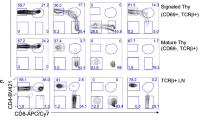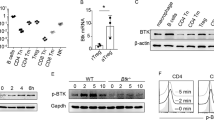Abstract
DURING T-cell development, site-specific DNA rearrangements mediating assembly of β- and α-chain genes of the T-cell receptor (TCR) are developmentally ordered1,2. In particular, assembly and expression of a complete β-chain gene blocks further rearrangements at the β-locus (a process referred to as allelic exclusion)3 and drives the generation and expansion of CD4+ 8+ cells4,5. Although the mechanism used by TCRβ chains to deliver such signals is unknown, studies in transgenic animals have suggested that the lymphocyte-specific protein tyrosine kinase p56lck may impinge on a similar signalling pathway6. The hypothesis that TCRβ chains deliver intracellular signals via p56lck makes an explicit prediction: that interference with p56lck function will mitigate the effects of a simultaneously expressed TCRβ chain. Here we confirm this prediction through examination of allelic exclusion in mice expressing both a functional TCRβ chain transgene and a catalytically inactive form of p56lck.
This is a preview of subscription content, access via your institution
Access options
Subscribe to this journal
Receive 51 print issues and online access
$199.00 per year
only $3.90 per issue
Buy this article
- Purchase on Springer Link
- Instant access to full article PDF
Prices may be subject to local taxes which are calculated during checkout
Similar content being viewed by others
References
von Boehmer, H. A. Rev. Immun. 6, 309–326 (1988).
Kronenberg, M., Siu, G. & Hood, L. E. A. Rev. Immun. 4, 529–591 (1986).
Uematsu, Y. et al. Cell 52, 831–841 (1988).
Mombaerts, P. et al. Nature 360, 225–231 (1992).
Shinkai, Y. et al. Science 259, 822–825 (1993).
Anderson, S. J., Abraham, K. M., Nakayama, T., Singer, A. & Perlmutter, R. M. EMBO J. 11, 4877–4886 (1992).
Glaichenhaus, N., Shastri, N., Littman, D. R. & Turner, J. M. Cell 64, 511–520 (1991).
Veillette, A., Bookman, M. A., Horak, E. M. & Bolen, J. B. Cell 55, 301–308 (1988).
Turner, J. M. et al. Cell 60, 755–765 (1990).
Molina, T. J. et al. Nature 357, 161–164 (1992).
Levin, S. D., Anderson, S. J., Forbush, K. A. & Perlmutter, R. M. EMBO J. 12, 1671–1680 (1993).
Mombaerts, P. et al. Cell 68, 869–877 (1992).
Shinkai, Y. et al. Cell 68, 855–867 (1992).
Perlmutter, R. M. et al. J. Cell Biochem. 38, 117–126 (1988).
Reynolds, P. J. et al. Molec. cell. Biol. 10, 4266–4270 (1990).
Wildin, R. S. et al. J. exp. Med. 173, 383–393 (1991).
Hatakeyama, M. et al. Science 252, 1523–1528 (1991).
Straus, D. B. & Weiss, A. Cell 70, 585–593 (1992).
Karnitz, L. et al. Molec. cell Biol. 12, 4521–4530 (1992).
Punt, J. A. et al. J. exp. Med. 174, 775–783 (1991).
Groettrup, M., Baron, A., Griffiths, G., Palacios, R. & von Boehmer, H. EMBO J. 11, 2735–2746 (1992).
Owen, J. J. T., Owen, M. J., Williams, G. T., Kingston, R. & Jenkinson, E. J. Immun. 63, 639–642 (1988).
Levelt, C. N., Ehrfeld, A. & Eichmann, K. J. exp. Med. 177, 707–716 (1993).
Sakaguchi, N. & Melchers, F. Nature 324, 579–582 (1986).
Kudo, A. & Melchers, F. EMBO J. 6, 2267–2272 (1987).
Kitamura, D. et al. Cell 69, 823–831 (1992).
Nussenzweig, M. C. et al. Science 236, 816–819 (1987).
Chou, H. S. et al. Proc. natn. Acad. Sci. U.S.A. 84, 1992–1996 (1987).
Author information
Authors and Affiliations
Rights and permissions
About this article
Cite this article
Anderson, S., Levin, S. & Perlmutter, R. Protein tyrosine kinase p56lck controls allelic exclusion of T-cell receptor β-chain genes. Nature 365, 552–554 (1993). https://doi.org/10.1038/365552a0
Received:
Accepted:
Issue Date:
DOI: https://doi.org/10.1038/365552a0
This article is cited by
-
Mesenchymal stromal cells support the viability and differentiation of thymocytes through direct contact in autologous co-cultures
Histochemistry and Cell Biology (2016)
-
Expression of T‐cell receptor genes during early T‐cell development
Immunology & Cell Biology (2008)
-
CMRL-T, a novel T-cell line showing asynchronous phenotype (CD34+/CD1a−/TCRαβ+) and dual T-cell receptor β chain
Leukemia (2006)
-
Transgenic analysis of thymocyte signal transduction
Nature Reviews Immunology (2002)
-
Human genetics: Past, present, and future, with special reference to major trends in Japan
Japanese Journal of Human Genetics (1997)
Comments
By submitting a comment you agree to abide by our Terms and Community Guidelines. If you find something abusive or that does not comply with our terms or guidelines please flag it as inappropriate.



